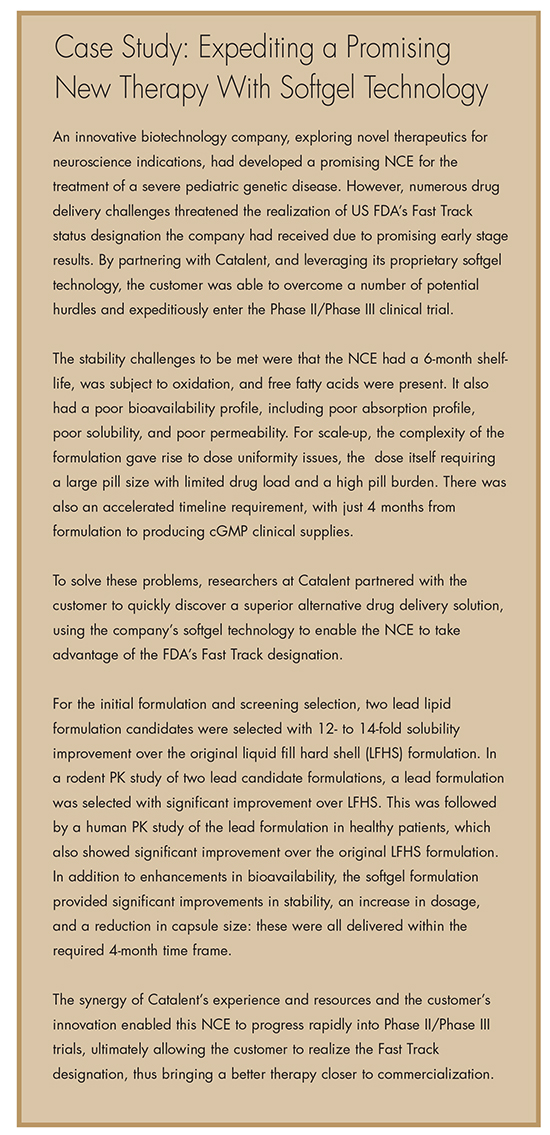Issue:April 2015
LIPID-BASED DELIVERY SYSTEMS - New Approaches for Macromolecule Oral Delivery, Abuse Deterrence & Bioavailability Enhancement
INTRODUCTION
Catalent Pharma Solutions has developed a broad range of advanced oral drug delivery technologies, including a toolkit of technologies based upon the broad application of lipid-based drug delivery systems (LBDDS) for optimum solubility enhancement. Through innovations to the company’s softgel technology, improved delivery of BCS Class II drugs is possible with OptiShell™, whilst OptiGel™ Bio enhances the membrane permeability allowing the non-invasive delivery of biomolecules, or narcotic compounds under a format that helps prevent abuse.
EXPANDING THE SOLUBILITY-ENHANCEMENT FRONTIERS
The company’s softgel technology has to date enabled more than 50 poorly soluble drugs (NDAs) to be commercialized, leveraging LBDDS and making it one of the most successful advanced drug delivery technologies applied to BCS Class II drugs. The basic principles ensure that the formulation delivers the drug substance under a solution form and maintains it in that form upon dispersion into the biological fluids before reaching the intestinal membrane. Softgel dosage forms offer broad flexibility for conversion to stable, unit-dosage forms and a wide variety of LBDDS formulation compositions. They also handle low fill formulation batch sizes of around 100 mg, and are thus perfectly suited for preclinical and early clinical studies.
Beyond the solubility hurdle, the poorly soluble drug candidates that Catalent is being tasked to formulate present more challenges in order to meet the desired target product profile. Unlike other delivery systems, LBDDS have the versatility to offer additional possibilities to formulation scientists.
Some poorly soluble drugs display excessive inter/intra individual variability that is often not compatible with their desired therapeutic effect (eg, positive food effects for highly lipophilic compounds for which the fed state increases in vivo intestinal solubility). Some strategies, specifically designed to leverage solubility and reduce variability, typically comprise a Self-Micro Emulsifying Drug Delivery System (SMEDDS) that is a lipid-based “preconcentrate” of solubilized drug composed of lipid excipients; surfactants and co-surfactants (hydrophilic or lipophilic), and co-solvents (eg, ethanol). When such formulations are diluted with gastrointestinal fluids, a thermodynamically stable microemulsion is formed, which maintains the drug in solution and prevents its precipitation irrespective of variations in biological conditions (ie, enzymes, pH, bile salts). Several successful compounds have reached market in this format.
Beyond solubility enhancement, some strategies also include the limitation of serum peak concentrations reducing Cmax/Cmin ratio. For this purpose, Catalent has designed and filed novel semi-solid formulations that combine solubility-enhancement properties while modulating release rate. These formulations are enabled by the company’s OptiShell technology that enables the encapsulation of various LBDDSs at higher temperatures.
OptiShell technology also helps overcome drug load limits (over 200 mg/g) of liquid lipid-based formulations. Indeed, when the industry faces poorly soluble drug candidates with high-targeted drug load (ie, most of the protein kinase inhibitors), formulation scientists have adopted the development of solid solution/dispersions either achieved by solubilizing in solvents and then evaporation (eg, Spray Drying, Spray Layering) or by melting in a polymer matrix and quenching (Hot Melt Extrusion). In contrast to those systems in which drug candidates are dispersed and stabilized at the molecular stage into polymeric hydrophilic matrices, OptiShell technology achieves solid solution/dispersions stabilized in solubility-enhancing lipid ingredients, with or without polymers. This approach offers a greater range of solutions to formulation scientists, together with easier paths to scale-up the manufacturing process and other benefits that are intrinsic to liquid and semi-solid systems, such as easier dose uniformity and containment.
Through the experience gained in formulating numerous poorly soluble drug candidates, Catalent’s scientists have concluded that LBDDS not only overcomes the solubility limitations of some APIs, but that these systems often also provide, beyond affecting membrane efflux, some benefits in modulating membrane permeability for drugs in which solubility is not the only biopharmaceutical hurdle to overcome. Since 2007, when Catalent initiated its research programs into this non-invasive delivery method for biologic drugs, this knowledge has been investigated and applied to macromolecules in development, and the outcomes of this research has been realized in the company’s OptiGelTM Bio technology.
CAPITALIZING ON PROPERTIES OF MACROMOLECULES
OptiGel Bio technology may significantly improve the delivery characteristics of peptide and biologic drugs. In order to meet the biopharmaceutical, stability, and delivery challenges they present, dosing of these macromolecules has traditionally been via injection. However, although this delivery form provides an adequate pharmacokinetic therapeutic profile for these drugs, such an invasive delivery method often results in difficulties with patient compliance and therefore does not enable some drugs with unique and established safety/efficacy profiles to match therapies requiring mid- to long-term treatment. The OptiGel Bio technology enables, through various combined mechanisms, the non-invasive delivery of some macromolecules. The most significant of these delivery mechanisms is the modulation of intestinal membrane permeability, combined with optimal targeted delivery in vivo.
The technology also bears some unique features in its design, enabling the reduction of intra/inter individual dose variability often met with some alternative technologies in development.
OptiGel Bio technology employs the same targeted co-delivery of permeation-enhancing formulations/systems techniques that have been safely applied to already marketed, poorly water-soluble drugs, to the delivery of macromolecules or peptides. Such localized delivery allows for higher transient concentrations of permeation-enhancing excipients alongside the API. The technology is applicable to various classes of macromolecules, including oligosaccharides as well as peptides, and Catalent is conducting research to further expand its application to the more complex delivery challenges associated with larger and less-stable molecules.
Catalent has created some standard preformulation and formulation screening models in order to quickly evaluate whether OptiGel Bio technology can assist in the delivery of candidate macromolecules, including peptides. These models have enabled the determination of potential structural changes to the peptides that would maximize the ability to cross the enterocyte along with the permeation-enhancing system when formulated.
Through the Catalent Applied Drug Delivery Institute, founded in 2013 to promote excellence in drug delivery through education, training, and innovation, Catalent has developed close partnerships with several universities. It is also expanding its academic partnerships through the newly established Non-invasive Macromolecule Consortium, which conducts clinical roundtable research and creates tools for future research, such as their Oral Drug Delivery Reference Guide. These partnerships, and other university relationships, promote the development of new, innovative technologies in the fields of taste-masking and bioavailability enhancement via particle engineering, hot melt extrusion, oral vaccines, and oral and non-invasive macromolecules.
NOVEL SOLUTIONS FOR ABUSE DETERRENCE
In 2013, of almost 50,000 drug overdose deaths in the United States, just less than 52% were related to pharmaceuticals, and more than 71% of those pharmaceutical-related deaths involved opioid analgesics (also called opioid pain relievers or prescription painkillers). Just as worryingly, the drug overdose death rate has more than doubled from 1999 through 2013.1
Abuse prevention is a key element in reducing the misuse of pharmaceuticals, and whilst Catalent is committed to resolving complex bioavailability limitations, the company has employed some of its learnings to the development of abuse deterrents that may be incorporated into pain management therapies. Many existing prevention methods currently available are costly, difficult to formulate, and/or require an elongated path to commercial development.
Catalent research teams have focused on studying rheologically complex fluids to develop OptiGelTM Lock, a unique abuse-deterrent technology that retains immediate- or sustained-released attributes while proposing the potential to meet Tier 3 labeling, described in the FDA Guidance for Industry: Abuse Deterrent Opiods – Evaluation and Labeling. This technology helps reduce the risks of abuse often associated with more conventional tablet forms, as a softgel is inherently more resistant to being ground-down and inhaled. It also significantly reduces the possibilities of abuse by manipulation and various extraction methods.
SUMMARY
The bioavailability of poorly soluble and permeable drugs, including macromolecules and peptides, can often be enhanced from lipid-based formulations. With more than 50 USNDAs approved, Catalent’s OptiGel Bio and OptiShell softgel technologies represent reliable dosage forms that may well assist in bringing not only poorly soluble drugs to market, but that also go beyond solving solubility limitations to incorporate benefits for those looking to deliver macromolecules and peptides, or controlled and potent drugs.
REFERENCE
1. Source: Centers for Disease Control and Prevention, “Prescription Drug Overdose in the United States: Fact Sheet.”
To view this issue and all back issues online, please visit www.drug-dev.com.

Julien Meissonnier provides technical and scientific leadership for the development of delivery systems for poorly soluble drugs that lead to approvable regulatory dossiers. He currently leads Catalent’s European softgel R&D teams, focused on early stage screening activities, developing products, scale-up and technology transfer, directing clinical supplies, and supporting product launches. Mr. Meissonnier has 17 years of experience in pharmaceutical development. He earned his Engineering degree in Physico-Chemistry from the ENSI in Caen, France. He also served as a Board Director of Alsace Biovalley innovation cluster and currently serves as a Catalent Applied Drug Delivery Institute Board Member. He can be reached at Julien.Meissonnier@catalent.com.
Total Page Views: 2271



















